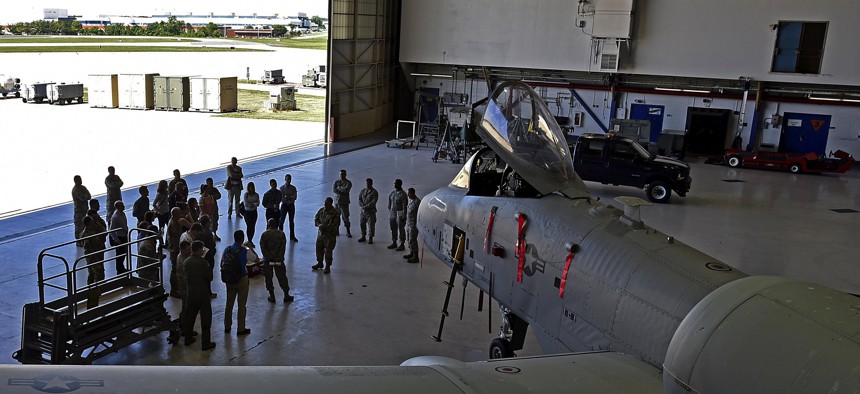
Members of the Office of the Cost Assessment and Program Evaluation listen to a briefing in the A-10 maintenance hangar at Warfield Air National Guard Base, Md., in 2017. U.S. Air National Guard / Airman Sarah M. McClanahan
Don’t Kill CAPE
The storied Cost Assessment and Program Evaluation office is invaluable to the Pentagon. Three former directors explain why.
In recently introduced legislation, the chairman of the House Armed Services Committee has proposed to close the Defense Secretary’s team of independent analysts, the storied Office of Cost Assessment and Program Evaluation. Along with directing the firing of the Director and her deputies, the draft legislation wipes out several laws written since 2009 that have charged the CAPE office with independent responsibilities for analyzing what sorts of major acquisition programs the military needs and what they are likely to cost.
While we are not familiar with the details of the apparent policy clash that has led to the chairman’s proposal, as former directors of the organization we do know that the disestablishment proposal is unwise and will undermine the efficiency and effectiveness of our national defense. The CAPE organization’s work is key for ensuring that resource decisions in the Department are strategy-driven, based on robust analysis, and informed by realistic cost assessments.
At a time when the national security challenges facing the Department demand joint solutions and creative responses to stiff competition from potential adversaries, CAPE provides valuable decision support to the Defense Secretary and other senior DOD leaders. In a typical year, each analyst in the office is responsible for reviewing an average of $30 billion in taxpayer funds, and develops an average of $1.5 billion in reallocation proposals for consideration by the Secretary and Deputy Secretary of Defense along with their senior leadership team of military and civilian officials. Perhaps understandably, those who benefit from the status quo are often uncomfortable with this detailed scrutiny by a team of highly skilled and independent analysts, but it is indispensable to have a smart and effective defense in a rapidly changing world. That’s why several countries around the world have sought to create similar organizations to advise their defense leaders.
The CAPE office has played a major role in the dramatic improvements in the performance of the defense acquisition system since 2009. By improving the data and analytic tools used to perform estimates of the cost of future acquisitions, and by institutionally insisting that those estimates be fully resourced, CAPE has helped to reduce the number of failing acquisition programs (as measured by breaches of the Nunn-McCurdy Act standards) from an average of 6.25 per year in the decade before the Weapon Systems Acquisition Reform Act of 2009, or WSARA, to 2.27 per year in the 12 years since that law’s passage. Measured another way, the median growth in costs of major defense acquisition programs initiated (Milestone B approval) during the ten years before WSARA was 27 percent, while in the ten years after WSARA, cost growth dropped to only 3 percent. These improvements mean that needed capabilities are reaching the force more consistently.
Since the office’s elevation in 2009, CAPE has also become a go-to organization for congressionally directed studies, with the annual defense authorization and appropriations bills tasking as many as 25 studies per year. These continued taskings illustrate the credibility of the CAPE organization even outside the Department.
In 2021, Congress created a commission to recommend reforms to the Department of Defense’s resource allocation process. The commission (on which one of us serves) is scheduled to issue its report next March, with a focus on improvements to “enable the United States to more effectively counter near-peer competitors by adopting new technologies more effectively and integrating and implementing those technologies into the field to respond to current and future threats.” Disestablishing the CAPE would be incompatible with many of the recommendations for improved analysis that the commission has heard from stakeholders and documented in its March 2023 Status Update to Congress.
There is always room for better consultation between the Department of Defense and the congressional leaders who are charged by our Constitution with raising armies, maintaining navies, and providing for the common defense. While political stakeholders will not always agree with every recommendation that emerges from a team of diligent independent analysts, hopefully upon further reflection they will agree that having a high quality and independent analytic function is an essential ingredient for building a world-class force in today’s challenging world.
Christine Fox was the first Director of Cost Assessment and Program Evaluation for the Department of Defense and later served as acting Deputy Secretary of Defense. Jamie Morin was the second Director of Cost Assessment and Program Evaluation for the Department of Defense and previously served as Acting Under Secretary of the Air Force. Bob Daigle was the third Director of Cost Assessment and Program Evaluation for the Department of Defense and previously served on the staff of the House Armed Services Committee.



